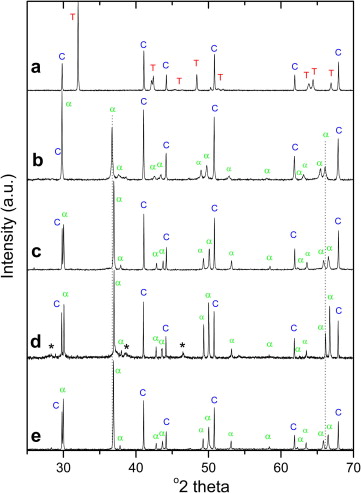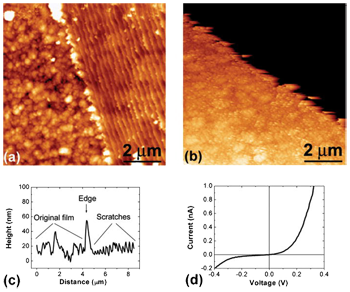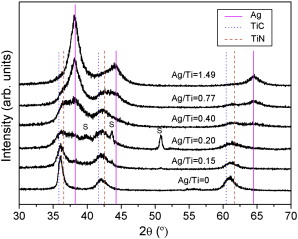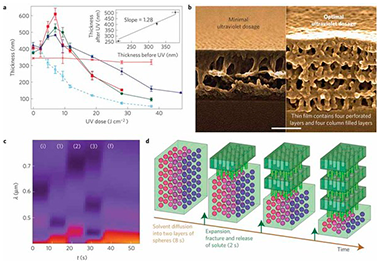Artículos SCI
2012
2012
Materiales de Diseño para la Energía y Medioambiente
Aluminum incorporation in alpha-PbO2 type TiO2 at pressures up to 20 GPa
Escudero, A; Langenhorst, FPhysics of the Earth and Planetary Interiors, 190 (2012) 87-94
Show abstract ▽

Aluminum incorporation into the high pressure polymorph of TiO2 with the structure of alpha-PbO2 has been studied from 10 to 20 GPa and 1300 degrees C by XRD, high-resolution Al-27 MAS-NMR and TEM. Al-doped alpha-PbO2 type TiO2 can be recovered at atmospheric pressure. Al2O3 solubility in alpha-PbO2 type TiO2 increases with increasing the synthesis pressure. The alpha-PbO2 type TiO2 polymorph is able to incorporate up to 35 wt.% Al2O3 at 13.6 GPa and 1300 degrees C, being the substitution of Ti4+ by Al3+ on normal octahedral sites and the formation of oxygen vacancies the mechanism of solubility. The transition to the higher pressure TiO2 polymorph with the ZrO2 baddeleyite structure, akaogiite, has not been observed in the quenched samples at room pressure. The microstructure of the recovered sample synthesized at 16 GPa and 1300 degrees C points to the existence of an intermediate non-quenchable aluminum titanium oxide phase at these conditions.
Enero, 2012 | DOI: 10.1016/j.pepi.2011.11.002
XRF, μ-XRD and μ-spectroscopic techniques for revealing the composition and structure of paint layers on polychrome sculptures after multiple restorations
Franquelo, ML; Duran, A; Castaing, J; Arquillo, D; Perez-Rodriguez, JLTalanta, 89 (2012) 462-469
Show abstract ▽

This paper presents the novel application of recently developed analytical techniques to the study of paint layers on sculptures that have been restored/repainted several times across centuries. Analyses were performed using portable XRF, μ-XRD and μ-Raman instruments. Other techniques, such as optical microscopy, SEM-EDX and μ-FTIR, were also used. Pigments and other materials including vermilion, minium, red lac, ivory black, lead white, barium white, zinc white (zincite), titanium white (rutile and anatase), lithopone, gold and brass were detected. Pigments from both ancient and modern times were found due to the different restorations/repaintings carried out. μ-Raman was very useful to characterise some pigments that were difficult to determine by μ-XRD. In some cases, pigments identification was only possible by combining results from the different analytical techniques used in this work. This work is the first article devoted to the study of sculpture cross-section samples using laboratory-made μ-XRD systems.
Enero, 2012 | DOI: 10.1016/j.talanta.2011.12.063
Materiales Nanoestructurados y Microestructura
Nanoscale mechanically induced structural and electrical changes in Ge 2Sb 2Te 5 films
Cecchini, R; Benitez, JJ; Sanchez-Lopez, JC; Fernandez, AJournal of Applied Physics, 111 (2012) 016101 (3 pages)
Show abstract ▽

We demonstrate that the microstructure and electrical properties of Ge2Sb2Te5 films can be changed by a nanoscale mechanical process. Nanoscratching is used to define modified areas onto an as-deposited crystalline Ge2Sb2Te5 film. Scanning tunneling microscopy measurements show that the modified areas have a very low electrical conductivity. Micro-Raman measurements indicate that the mechanically induced microstructural changes are consistent with a phase transformation from crystalline to amorphous, which can be reversed by laser irradiation.
Enero, 2012 | DOI: 10.1063/1.3673592
Materiales Nanoestructurados y Microestructura
Influence of silver content on the tribomechanical behavior on Ag-TiCN bioactive coatings
Sanchez-Lopez, JC; Abad, MD; Carvalho, I; Galindo, RE; Benito, N; Ribeiro, S; Henriques, M; Cavaleiro, A; Carvalho, SSurface and Coatings Technology, 206 (2012) 2192-2198
Show abstract ▽

Surface modification of bulk materials used in biomedical applications has become an important prerequisite for better biocompatibility. In particular, to overcome the particle generation, low-wear coatings based on carbon (nitrogen) and containing antimicrobial elements such as silver are promising candidates. Thus, the present work explores the potentialities of silver-containing carbonitride-based (Ag-TiCN) thin films prepared by direct current unbalanced reactive magnetron sputtering. The silver content in the coatings was varied from 0 to 26.7at.% by changing the targets and the fraction of C 2H 2 and N 2 in the gas mixture with Ar. The obtained Ag-TiCN based coatings were characterized in terms of composition and microstructure. Mechanical and tribological properties of the films were studied by nanoindentation and reciprocating pin-on disk testing in a fetal bovine serum solution, respectively. Raman, scanning electron microscope and energy dispersive X-ray analysis was carried out in the contact region after tribological tests to obtain information about the friction mechanism. The cytotoxicity of the coatings was assessed by in vitro tests using fibroblast cells. The coatings comprised a mixture of TiC xN 1-x, Ag and a-C(N) x phases whose relative proportion varied depending on the Ag/Ti ratio. The mechanical, tribological and cytotoxicity properties were correlated with the chemical and phase composition. When the Ag/Ti ratios were below 0.20 (Ag contents <6.3at.%) the films resulted harder (~18GPa) with higher wear resistance (~10 -6mm 3/Nm), showing similar friction coefficient (~0.3) and good biocompatibility.
Enero, 2012 | DOI: 10.1016/j.surfcoat.2011.09.059
Materiales Ópticos Multifuncionales
Collective osmotic shock in ordered materials
Paul Zavala-Rivera, Kevin Channon, Vincent Nguyen, Easan Sivaniah, Dinesh Kabra, Richard H. Friend, S. K. Nataraj, Shaheen A. Al-Muhtaseb, Alexander Hexemer, Mauricio E. Calvo & Hernan MiguezNature Materials, 11 (2012) 53–57
Show abstract ▽

Osmotic shock in a vesicle or cell is the stress build-up and subsequent rupture of the phospholipid membrane that occurs when a relatively high concentration of salt is unable to cross the membrane and instead an inflow of water alleviates the salt concentration gradient. This is a well-known failure mechanism for cells and vesicles (for example, hypotonic shock) and metal alloys (for example, hydrogen embrittlement). We propose the concept of collective osmotic shock, whereby a coordinated explosive fracture resulting from multiplexing the singular effects of osmotic shock at discrete sites within an ordered material results in regular bicontinuous structures. The concept is demonstrated here using self-assembled block copolymer micelles, yet it is applicable to organized heterogeneous materials where a minority component can be selectively degraded and solvated whilst ensconced in a matrix capable of plastic deformation. We discuss the application of these self-supported, perforated multilayer materials in photonics, nanofiltration and optoelectronics.
Enero, 2012 | DOI: 10.1038/nmat3179
- ‹ anterior
- 341 of 422
- siguiente ›














